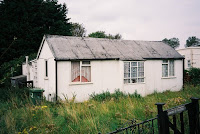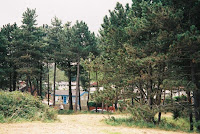Gibraltar Point Nature Reserve and Field Centre:
Four miles north or north-east of Skegness lay Gibraltar Point, a very sea wilderness. The sea at low tide went out of sight, and left samphire-covered flats and tiny rivulets of salt sea water and cockles; further and further it receded and left bare to the sunshine miles on miles of mud that shone like burnished ore. Nothing but the great stakes that guided the fisher-boats at flow of tide, broke the level prospect, save here and there a rusted anchor or the ribs of a wreck. The silence of the vast world of mud and sans and samphire was only disturbed by the cry of stints or curlew; it was to this wilderness, devoid of man, that Alfred Tennyson delighted to wander.
(Rawnsley, HD, 1900, p.57)
In Memories of the Tennysons Rawnsley recounts discovering Tennysons fondness for this ‘wilderness’ from an elderly resident of a farm house at Gibraltar Point who recalled a local musician who returning home in the early hours of the morning found “Mr Alfred, a raavin and taavin’ upon the sand-hills in his shirt sleeves an’ all”. Gibraltar Point, like Skegness, only became easily accessible to visitors in 1873 with the arrival of the railways, prior to that it had been:
Known for its bramble hills, the quiet pub (The Old Ship Inn, possibly dating back to the eighteenth century), the coastguard station and barges in Wainfleet Haven... In the 1890s there was a Noah’s Ark Hotel – a one-time pilot vessel anchored to keep it from floating out of its temporary dry dock on a flood tide...
(Robinson, p49-50, 1969)
In the 1929 the Tyrwhitt Drake estate sold off a parcel of land in Croft Parish to Messrs Hyams and Giles of Skegness who planned to develop a garden city on the site, their plans fell through and they sold 200 acres of the sandhills near Skegness to Maclean Estates who planned to build the Tennyson Glen Estate. Only three of the planned eight hundred houses were built (what is now Aylmer Avenue) and when in 1934 Maclean Estates went into liquidation Lindsey County Council (LCC) purchased the land from there for £12,000. The area had already caught the eye of conservationists, local and national and the National Trust, who regarded it as “of considerable interest and beauty” recommended its preservation. In 1937 a further 190 acres of land were purchased by the LCC as “a public open space and wild bird sanctuary”. The LCC’s purchase of the land was allowed by the LCC (Sandhills) Act of 1932 which sought to protect the sandhills landscape form development of both permanent and makeshift varieties. During the Second World War, Gibraltar Point, along with the rest of the Lincolnshire coast was occupied by the military. In 1948 the LCC were presented with a memorandum for consideration, Gibraltar Point as a Nature Reserve, submitted by the newly established (by a matter of days) Lincolnshire Naturalists Trust (LNT, formerly the Lincolnshire Naturalist Union).
The popular concept of a nature reserve at the time was of a place not designed to encourage visitors... We knew Gibraltar Point had to be different. It would for the most part be open to the public, and management would have reconcile that with the conservation of the wildlife and natural features which people would come to see, study and enjoy.
(Smith, 2007, p.54)
Ted Smith’s detailed account of the process of securing Gibraltar Point as a nature reserve acknowledges the influence on the LNT of the Wildlife Conservation Special Committee and of the writings of Sir Arthur Tansley in aiming to create a nature reserve that functioned as an “outdoor laboratory and living museum”. The new nature reserve was officially managed by the LCC with its day to day administration given to the LNT; it was the first example of a nature reserve where local government and a voluntary body worked as a partnership and in 1952 became the first example of a local authority reserve to be designated as such in England and Wales under the National Parks and Access to the Countryside Act of 1949. In spite of the uniqueness of Gibraltar Point it was still at risk from aspects of development. Mr Hyams (of the garden city plans) still owned one of the few buildings on the site, Sykes Farm, which had burned down during the army’s occupation of the area during the Second World War. Hyams proposed demolishing what was left of the farm and converting the area into a caravan park. In spite of fierce opposition from conservation groups permission was granted for a 300 berth caravan park with recreational facilities and a shop. The Lincolnshire Naturalists Trust were convinced that the nature reserve could not co-exist alongside such a development and lobbied the LCC and the Sandhills Sub Committee, claiming that the development would destroy the scientific potential of the area and make study impossible. In 1953 the LCC were persuaded to put a compulsory purchase order on the Sykes Farm site and it was secured as part of the reserve. Other areas which were still in private ownership were gradually acquired by the LCC and the land added to the nature reserve.
Gibraltar Point was, from the first, intended to provide a location for study and was used extensively by the University of Nottingham, a connection emphasised by Ted Smith and By David Robinson in their books on the Lincolnshire Coast as both authors worked as extra mural tutors in the Lindsey area and had strong connections with Gibraltar Point. In the early days student accommodation was a makeshift and basic kind, including an old Nottingham Transport bus body know as ‘Fred’s Place’ after Fed Gunnill, a retired sailor, who had lived in it during the war years. Other accommodation included the huts left by the military after the war, an old gun emplacement (‘Lill’s Hut’) and from 1958 the old Coastguard House which was assigned for use as a Field Centre by the LNT by the LCC and converted with funds from the Lindsey Village Welfare Fund and the Nature Conservancy. By 1962 further accommodation and educational facilities were required and the County Architect produced plans for a field centre that included labs, dormitories, teaching rooms, a common room, dining room and kitchen:
They were arranged around the existing buildings of which the coastguard house tower formed a central feature. The walls were slate hung and the whole building was designed to harmonise with its setting of dune and salt marsh.
(Smith, 2007, p.84)
The Field Centre at Gibraltar Point provided a venue for the teaching of field studies to pupils from schools in Lincolnshire and the midlands counties and for students from the midlands universities. The role of the University of Nottingham Adult Education department, once a major user of the facilities, declined during the 1990s. In the 2000s the University withdrew its Adult Education provision from the regions and its residential courses on the coast ended.
Smith E (2009) Trustees for Nature, Horncastle: Lincolnshire Wildlife Trust
Rawnsley HD, Rawnsley WF & Rawnsley RDB, (1900) Memories of the Tennysons Glasgow: James McLehose and Sons, Bibliolife reproduction series.
Robinson D (1981) The Book of the Lincolnshire Seaside, Buckingham: Baron
Robinson D (1969) Gibraltar Point Nature Reserve, Lincolnshire Life 9, 6: 48-51





